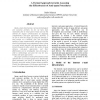Free Online Productivity Tools
i2Speak
i2Symbol
i2OCR
iTex2Img
iWeb2Print
iWeb2Shot
i2Type
iPdf2Split
iPdf2Merge
i2Bopomofo
i2Arabic
i2Style
i2Image
i2PDF
iLatex2Rtf
Sci2ools
HICSS
2006
IEEE
2006
IEEE
A Formal Approach towards Assessing the Effectiveness of Anti-Spam Procedures
Spam e-mails have become a serious technological and economic problem. So far we have been reasonably able to resist spam e-mails and use the Internet for regular communication by deploying complementary anti-spam approaches. However, if we are to avert the danger of losing the Internet email service as a valuable, free, and worldwide medium of open communication, anti-spam activities should be performed more systematically than is done in current, mainly heuristic, anti-spam approaches. A formal framework within which the modes of spam delivery, anti-spam approaches, and their effectiveness can be investigated, may encourage a shift in methodology and pave the way for new, holistic anti-spam approaches. This paper presents a model of the Internet e-mail infrastructure as a directed graph and a deterministic finite automaton, and draws on automata theory to formally derive the modes of spam delivery possible. Finally the effectiveness of anti-spam approaches in terms of coverage of sp...
Anti-spam Approaches | Biometrics | Complementary Anti-spam Approaches | HICSS 2006 | Spam E-mails | System Sciences |
| Added | 11 Jun 2010 |
| Updated | 11 Jun 2010 |
| Type | Conference |
| Year | 2006 |
| Where | HICSS |
| Authors | Guido Schryen |
Comments (0)

